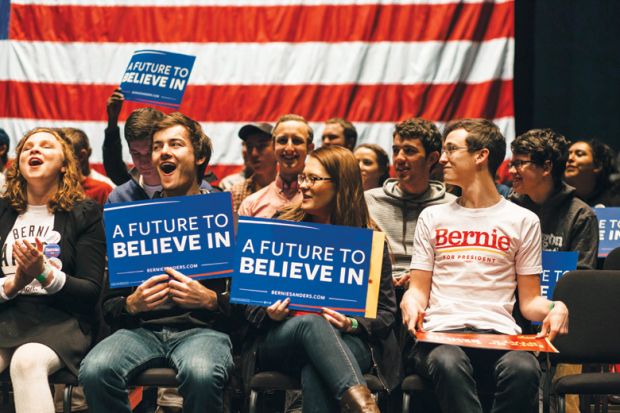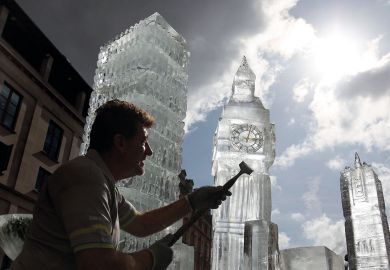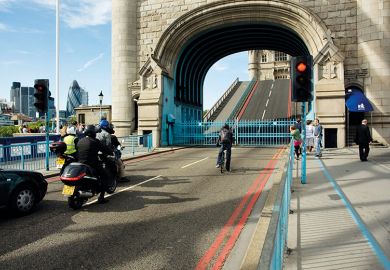When the Nashville-based American musician Ben Rector made an appearance at Mercer University in the southern state of Georgia, more than a third of the 3,000 students showed up.
They heard his chart-topping pop rock – and an appeal from him that they vote.
In a US presidential election year with candidates talking about such issues as tuition costs and student debt, and with huge numbers of young people showing up at rallies and demonstrations, activists are working frantically to convert this energy into votes.
Joey Wozniak – a student at Mercer who leads efforts to get his peers to vote, including bringing the concert to the campus – said that there was excitement about the election among the student body. “Whether or not that translates into higher youth voter turnout, I don’t know,” he added.
To judge from history, the odds are against it. In the 2012 presidential election, only 45 per cent of university students voted, according to the National Study of Learning, Voting, and Engagement, based at Tufts University. That was lower than overall turnout, which was 54 per cent.
One reason for the low participation might be that this generation of undergraduates has grown up almost entirely in a time of partisan intransigence and political dysfunction.
However, this year may be different in terms of student political participation, some observers say.
In state primary elections to select a nominee, students have been voting in large numbers – especially on the Republican side. In those contests, students have disproportionately supported opponents of Donald Trump, who is nevertheless the party’s presumptive presidential nominee.
“There is a contingent of young people coming out just to vote for anyone but Trump,” said Kei Kawashima-Ginsberg, director of the Center for Information and Research on Civic Learning and Engagement at Tufts.
On the Democratic side, students have given their votes overwhelmingly to Bernie Sanders over Hillary Clinton, in some cases by a margin of four to one.
“There is a sense of ownership among young people of the bigger issues [Mr Sanders] represents,” such as climate change and income inequality, Dr Kawashima-Ginsberg said.
But students have not needed party organisations to stimulate their involvement. In a year of massive demonstrations on campuses about issues such as racial diversity, they have become emboldened to act without prompting.
When Mr Trump planned a rally in Chicago, for example, students joined other activists in using social media to organise a protest so big that it forced him to cancel the appearance.
Considering that they already seem to dislike Mr Trump, and that Mr Sanders is unlikely to be the Democratic candidate for president, Dr Kawashima-Ginsberg said that “the risk is that the current parties, both Democrat and Republican, really have alienated many young people”.
But Mr Wozniak, who will have to repay loans of $25,000 (£17,330) taken out to help pay for his education, said: “We have not had issues that directly affected us addressed on this large a scale before.
“This is the first election that someone is looking at students and saying, ‘Wake up. You’re being affected over and over again, and you’re not translating that to the polls.’ People aren’t going to listen unless we work within the system.”
He and others at Mercer have organised a contest among the universities of the Southern Conference – an athletics league whose members compete in basketball, American football and other sports – to see which can do the most to increase voting among its students.
At California Polytechnic State University, students made a music video as part of a get-out-the-vote campaign, set to the tune of the Iggy Azalea hip hop hit Fancy. “Students, voice your vote and let the whole world hear it,” goes the rap.
Another organisation, TurboVote, uses technology to help tech-savvy students register on time, deal with the often-complicated process of voting, and remind them when the polls are open.
“This is a problem that technology can solve,” said TurboVote spokesman Brandon Naylor.
Some universities themselves, which are increasingly at the mercy of local, state and federal authorities for everything from building permits to funding, also recognise the value of having their students vote, although public institutions are forbidden from being partisan.
One, Montclair State University in New Jersey, declared its own voting district to make it easier for its students to cast their ballots.
Those kinds of logistical issues have a surprising impact.
“One of the things you’re fighting with college students is getting them to give their time for anything,” said Adam Reynolds, a student voting activist at the University of Chicago who helped arrange for buses to take classmates to the polls in the state primary elections in March.
But he is optimistic that students this year are more motivated than ever to vote.
“We’ve been presented with a series of options that scare people,” Mr Reynolds said. “And often fear will get people to go out and do things.”
后记
Print headline: Fear factor energises students to rally vote




